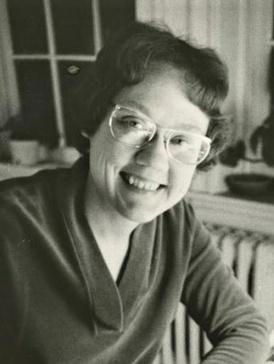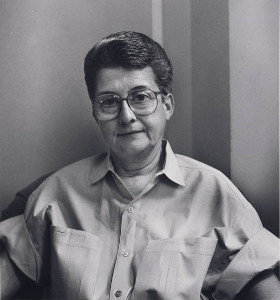Related Research Articles

Dorothy Louise Taliaferro "Del" Martin and Phyllis Ann Lyon were an American lesbian couple based in San Francisco who were known as feminist and gay-rights activists.

The Daughters of Bilitis, also called the DOB or the Daughters, was the first lesbian civil and political rights organization in the United States. The organization, formed in San Francisco in 1955, was initially conceived as a secret social club, an alternative to lesbian bars, which were subject to raids and police harassment.

The Ladder was the first nationally distributed lesbian publication in the United States. Published from 1956 to 1972, The Ladder was the primary monthly publication and method of communication for the Daughters of Bilitis (DOB), the first lesbian organization in the US. It was supported by ONE, Inc. and the Mattachine Society, with whom the DOB retained friendly relations. The name of the magazine was derived from the artwork on its first cover, simple line drawings showing figures moving towards a ladder that disappeared into the clouds.

Barbara Gittings was an American activist for LGBT equality. She organized the New York chapter of the Daughters of Bilitis (DOB) from 1958 to 1963, edited the national DOB magazine The Ladder from 1963 to 1966, and worked closely with Frank Kameny in the 1960s on the first picket lines that brought attention to the ban on employment of gay people by the largest employer in the US at that time: the United States government. Her early experiences with trying to learn more about lesbianism fueled her lifetime work with libraries. In the 1970s, Gittings was most involved in the American Library Association, especially its gay caucus, the first such in a professional organization, in order to promote positive literature about homosexuality in libraries. She was a part of the movement to get the American Psychiatric Association to drop homosexuality as a mental illness in 1972. Her self-described life mission was to tear away the "shroud of invisibility" related to homosexuality, which had theretofore been associated with crime and mental illness.

Edythe D. Eyde better known by her pen name Lisa Ben, was an American editor, author, active fantasy-fiction fan and fanzine contributor, and songwriter. She created the first known lesbian publication in North America, Vice Versa. Ben produced the magazine for a year and distributed it locally in Los Angeles, California, in the late 1940s. She was also active in lesbian bars as a musician in the years following her involvement with Vice Versa. Eyde has been recognized as a pioneer in the LGBT movement.

Alma Routsong was an American novelist best known for her lesbian fiction, published under the pen name Isabel Miller.

Barbara Grier was an American writer and publisher. She is credited for having built the lesbian book industry. After editing The Ladder magazine, published by the lesbian civil rights group Daughters of Bilitis, she co-founded a lesbian book-publishing company Naiad Press, which achieved publicity and became the world's largest publisher of lesbian books. She built a major collection of lesbian literature, catalogued with detailed indexing of topics.

LGBTQ movements in the United States comprise an interwoven history of lesbian, gay, bisexual, transgender and queer social movements in the United States of America, beginning in the early 20th century. A commonly stated goal among these movements is social equality for LGBTQ people. Some have also focused on building LGBTQ communities or worked towards liberation for the broader society from biphobia, homophobia, and transphobia. LGBTQ movements organized today are made up of a wide range of political activism and cultural activity, including lobbying, street marches, social groups, media, art, and research. Sociologist Mary Bernstein writes:
For the lesbian and gay movement, then, cultural goals include challenging dominant constructions of masculinity and femininity, homophobia, and the primacy of the gendered heterosexual nuclear family (heteronormativity). Political goals include changing laws and policies in order to gain new rights, benefits, and protections from harm.
The North American Conference of Homophile Organizations was an umbrella organization for a number of homophile organizations. Founded in 1966, the goal of NACHO was to expand coordination among homophile organizations throughout the Americas. Homophile activists were motivated in part by an increase in mainstream media attention to gay issues. Some feared that without a centralized organization, the movement would be hijacked, in the words of founding member Foster Gunnison Jr., by "fringe elements, beatniks, and other professional non-conformists".
The Council on Religion and the Homosexual (CRH) was a San Francisco, California, United States–based organization founded in 1964 for the purpose of joining homosexual activists and religious leaders.

Martha Shelley is an American activist, writer, and poet best known for her involvement in lesbian feminist activism.

Jeanne Córdova was an American writer and supporter of the lesbian and gay rights movement, founder of The Lesbian Tide, and a founder of the West Coast LGBT movement. A former Catholic nun, Córdova was a second-wave feminist lesbian activist and self-described butch.

Ernestine Eckstein was an African-American woman who helped steer the United States Lesbian and Gay rights movement during the 1960s. She was a leader in the New York chapter of Daughters of Bilitis (DOB). Her influence helped the DOB move away from negotiating with medical professionals and towards tactics of public demonstrations. Her understanding of, and work in, the Civil Rights Movement lent valuable experience on public protest to the lesbian and gay movement. Eckstein worked among activists such as Phyllis Lyon and Del Martin, Barbara Gittings, Franklin Kameny, and Randy Wicker. In the 1970s she became involved in the black feminist movement, in particular the organization Black Women Organized for Action (BWOA).
Helen Jane "Sandy" Sandoz, also known by her pseudonym Helen Sanders, was an American lesbian rights activist and writer. She was involved in the Daughters of Bilitis and its official publication, The Ladder, from 1956 to 1970.
Stella Rush, also known by her pen name Sten Russell, was an American journalist and LGBT rights activist. She was a regular reporter for the gay rights magazine ONE (1954–1961) and the lesbian rights magazine The Ladder (1957–1968).

Shirley Willer was an American feminist and activist. Born in Chicago, Illinois, Willer joined the Daughters of Bilitis (DOB) in the 1950s and became the president of the organization a few years after. Because of her energy and dedication, she helped to revolutionize the homophile movement in the 1960s and helped pave the way for future civil rights advancements for the gay community.
The National LGBTQ Wall of Honor is a memorial wall in the Greenwich Village neighborhood of Manhattan in New York City, dedicated to LGBTQ "pioneers, trailblazers, and heroes". Located inside the Stonewall Inn, the wall is part of the Stonewall National Monument, the first U.S. National Monument dedicated to the country's LGBTQ rights and history. The first fifty inductees were unveiled June 27, 2019, as a part of events marking the 50th anniversary of Stonewall. Five honorees are added annually.
The Lesbian Mothers Union (LMU), later known as Lesbian Mothers and Friends, was created by Del Martin and Pat Norman, along with other activists, in an effort to combat the legal persecution and separation from society that lesbian mothers face. Lesbian mothers were in desperate need of support, and the Lesbian Mothers Union offered assistance to those residing in the San Francisco Bay area.
Billye Talmadge, also known as Billie Tallmij, was a lesbian American activist and educator at the forefront of the burgeoning gay liberation movement in the 1950-60s as well as a founding member of the Daughters of Bilitis, the first organization established to fight explicitly for lesbian civil and political rights in the United States. Her main focus was empowering lesbian youth through education and counseling at a time when many homosexual and lesbian voices had been silenced by the current social and political climate.
Cleo Bonner, also known as Cleo Glenn, served as president of the Daughters of Bilitis and circulation manager of The Ladder magazine in the 1960s. She was one of the first African-American women to belong to this organization. Barbara Gittings referred to Cleo Glenn as a "fireball".
References
- 1 2 Lipsky, Bill (2022-02-10). "Pat, Cleo, and Ernestine: Pioneering Black Members of the Daughters of Bilitis". San Francisco Bay Times. Retrieved 2024-06-24.
- 1 2 3 4 5 6 Gallo, Marcia M. (September 8, 2007). Different Daughters: A History of the Daughters of Bilitis and the Rise of the Lesbian Rights Movement (PDF). Seal Press. ISBN 978-1580052528.
- 1 2 3 4 Bullough, Vern L.; Saunders, Judith M.; Valente, Sharon; White, C. Todd, eds. (2008). "Pat Walker (1938-1999)". Before Stonewall: Activists For Gay and Lesbian Rights in Historical Context (PDF). Haworth Gay & Lesbian Studies. New York: Routledge. ISBN 978-1-56023-193-6.
- ↑ Hanna, Katelyn (2022-05-20). "Pride in the Past: A Photo Essay". Herstory. Retrieved 2024-06-24.
- 1 2 "Pat Walker, October 18, 1988 · Lesbian Herstory Archives AudioVisual Collections". herstories.prattinfoschool.nyc. Retrieved 2024-06-25.
- ↑ Faderman, Lillian (2015). The Gay Revolution: The Story of the Struggle. Internet Archive. New York: Simon & Schuster. p. 662. ISBN 978-1-4516-9411-6.
- ↑ "The Queer Past Becomes Present". GLBT Historical Society (in French). Retrieved 2024-06-25.